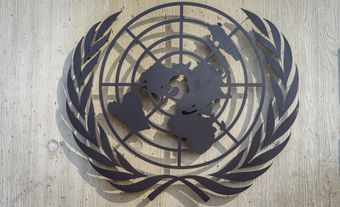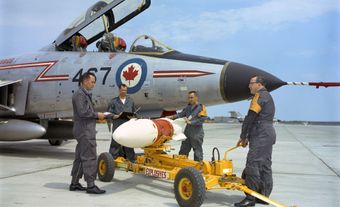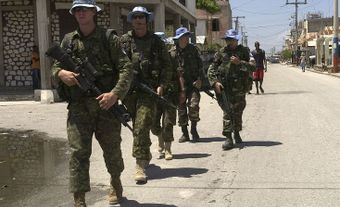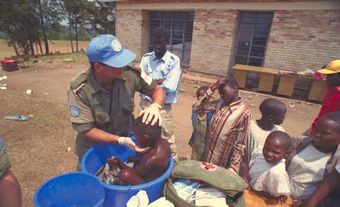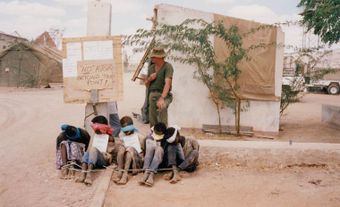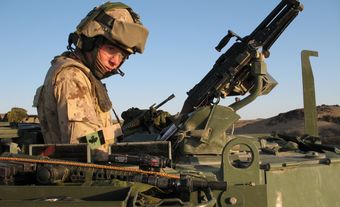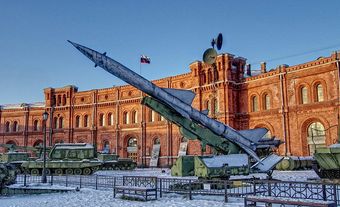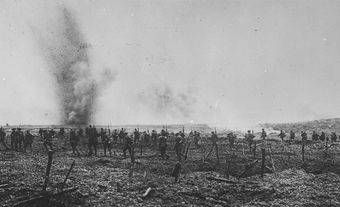In the mid-1990s, Canada became a global leader in the effort to eradicate land mines, which are explosive and deadly weapons. In December 1997, representatives from 122 countries assembled in Ottawa to sign the Mine Ban Treaty (or Ottawa Treaty), which came into force on 1 March 1999. With over 80 per cent of the countries in the world having signed the treaty, it is one of the most widely accepted. The Canadian government continues to support demining efforts globally by assisting in related United Nations operations, supporting organizations like the International Campaign to Ban Landmines, and providing training, education and funding for mine clearing.
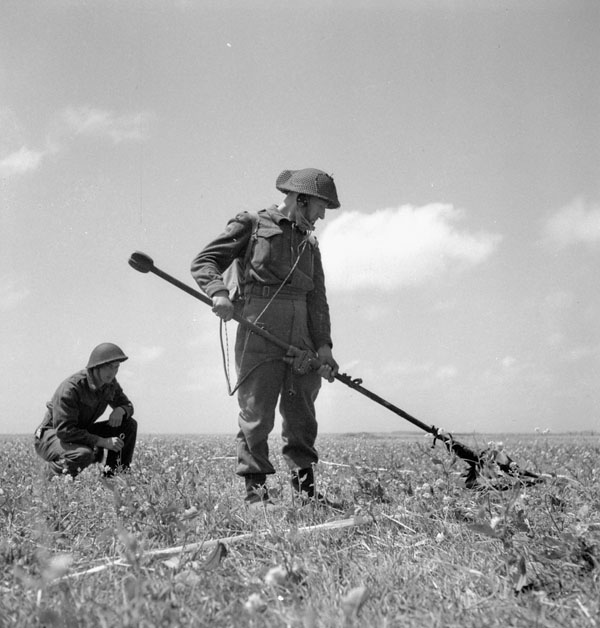
What Is A Land Mine?
Land mines, used in zones of conflict to prevent access, are containers filled with explosives that are triggered by tripwire or pressure. Usually camouflaged or hidden, the devices maim and can kill when a person or vehicle unknowingly detonates them. Land mines are small, inexpensive and easy to deploy. The area the mines are laid in is generally known as a minefield.
There are different types of land mines. Anti-personnel mines are small, typically less than 10 cm in diameter. They are designed to kill or injure the person who triggers it. Anti-tank mines are only triggered by the heavy weight of vehicles. Vehicles that trigger anti-tank mines are destroyed. Often the people inside the vehicle are killed or injured as well.
The direct blast of a land mine can kill and maim, but so too can the fragments that are hurled by the explosion. Land mines remain active years after a conflict has ended. Therefore, they pose threats to civilians, such as farmers trying to rebuild the land, and especially to children, who might pick up a land mine, mistaking it for a harmless object. The International Campaign to Ban Landmines (ICBL) reported that in 2018, children accounted for 54 per cent of civilians killed by land mines.
History of Land Mines
Some of the earliest versions of land mines were developed during the First World War for use against battle tanks. Between 1918 and 1939, the development and use of anti-personnel mines became a priority among military strategists. These mines were targeted at soldiers and linked to specific military objectives. By the 1960s and 1970s, during the Cold War, the use of land mines by government forces and guerrilla armies was widespread and random dissemination of mines was common.
Millions of anti-personnel mines have been left behind in the battle zones of more than 55 countries. Precise estimates on the numbers of mines are difficult because many of the forces that laid mines kept poor records. Mines made of plastic are difficult to detect and the process of removing them by hand is extremely slow and labour-intensive. In mine-affected areas, civilians have been unable to work fields where mines have been sown or have found their paths to drinking water supplies or firewood cut off.
The movement to do something about these weapons began toward the end of the Cold War. By 1992, a coalition of non-governmental organizations from different nations joined under the umbrella group International Campaign to Ban Landmines to call for the elimination of anti-personnel mines.
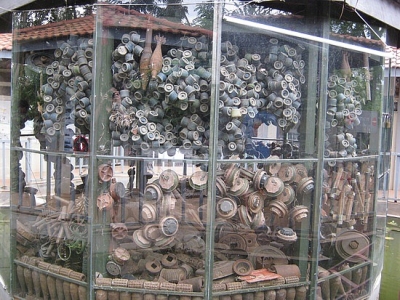
Disarmament and the Ottawa Treaty
Early efforts towards the eradication of land mines concentrated on the United Nations disarmament system. Anti-mines activists soon became disenchanted with what they viewed as a bureaucratic and cumbersome process. Non-governmental organizations began raising international awareness about the impact of anti-personnel mines in 1992.
Prime Minister Jean Chrétien discussed a ban on land mines with fellow leaders at the G7 summit in 1995. In January 1996, Canada, France and Switzerland announced a moratorium on the use, production, trade and export of anti-personnel mines. In May 1996, countries met to amend the 1980 UN Convention on Prohibitions or Restrictions on the Use of Certain Conventional Weapons. The enhanced restrictions on mines, however, did not satisfy all of them. A small group of countries meeting in Geneva decided that a total ban was necessary. The Canadian government, concerned that a commitment to outlaw mines would be watered down, said another conference should be held before the end of the year. The conference then occurred in October of that year.
From this point on, the movement to ban land mines moved with astonishing speed. Fifty nations met in Ottawa to explore the idea of a global ban. Some had reservations, considering that land mines were an effective part of their military arsenal. Although prominent military figures have disputed the validity of this argument, the United States has persistently refused to consider participation in the land mines ban for this reason. Canada's foreign affairs minister, Lloyd Axworthy, surprised delegates at this gathering when he sidestepped traditional diplomacy and announced that Canada would convene another meeting in December 1997 to conclude a pact to forbid the use, production or export of anti-personnel mines.
In October 1997, the coordinator of the International Campaign to Ban Landmines, Jody Williams of the United States, received the Nobel Peace Prize for spearheading the six-year drive. A month later, Canada began the task of destroying its stockpile of mines. On 3-4 December 1997, officials from 122 countries gathered in Ottawa to sign a treaty aimed at ridding the world of anti-personnel mines. The meetings culminated in the signing of the Mine Ban Treaty (or the Ottawa Treaty), which came into force on 1 March 1999. The treaty called for member states to destroy their stockpiled mines within four years. Delegates were asked to accept the treaty's terms without further negotiation.
More than 20 years after its adoption, 164 state parties have ratified the Ottawa Treaty, and 33 that were once heavily mined are now considered free of anti-personnel mines. In 2014, the countries that were signatories to the Ottawa Treaty set themselves the target of eradicating land mines completely by 2025.
Non-compliance
As of 2020, 32 state parties have not signed the Ottawa Treaty, including some of the world’s largest manufacturers of mines, such as the United States, China and Russia.
Additionally, efforts to clear fields of mines did not quicken noticeably in the wake of the treaty, even as countries poured money into developing new clearance technologies. Much of the technology to remove mines, such as heavy demining vehicles, is expensive, and therefore might not be appropriate for use in developing countries. Another way of demining is to hire demobilized soldiers to clear former war zones through conventional methods. Regardless of the method, mines are being removed and the threat of injury to civilians is lessening in some parts of the world.
Land mines are far from a thing of the past. Beginning in December 2001, India and Pakistan conducted the largest mine-laying operations in many years, locating anti-personnel mines along their 2,800 km common border. In 2001–02, warring factions in Afghanistan used anti-personnel mines, despite extensive mine-clearing operations in the late 1990s and the country's joining the Ottawa Treaty on 11 September 2002. The army in Nepal planted mines until at least the end of the insurgency in that country in 2006. In Myanmar, government troops continue to use mines extensively.
Among the countries still using or stockpiling anti-personnel land mines since at least 2019 are Russia, China, Pakistan and India.
Mine-clearing Efforts
The ICBL monitors the progress of mine-clearing efforts worldwide. Mine-clearing operations are carried out both by non-governmental organizations, such as the Mines Advisory Group and the HALO Trust, and by businesses, such as BACTEC, a group of companies that specialize in land mine and battle area clearance.
The Canadian Landmine Foundation (CLMF) is a registered charity that aims to raise funds and awareness about land mines and their damaging effects. It supports demining, educational programming and victim assistance. As of 2022, the CLMF funded $3.7 million of projects such as training mine-detection dogs and creating robotic technology for demining.
Canada has supported demining operations in countries like Afghanistan, Cambodia and Bosnia, by training and funding mine awareness and mine-removal programs. Canada supports UN demining operations as well as the related programs of organizations like ICBL.

 Share on Facebook
Share on Facebook Share on X
Share on X Share by Email
Share by Email Share on Google Classroom
Share on Google Classroom



